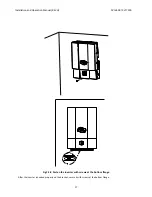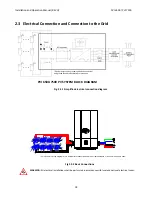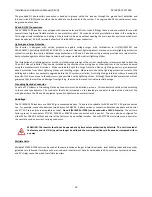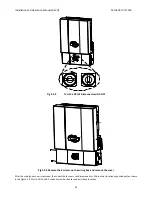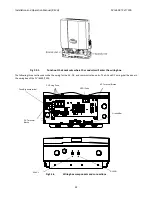
Installation
and
Operation
Manual
(REV
H)
PVI
6500
/
PVI
7500
8
The
concept
of
stringing
PV
modules
The
use
of
a
PV
string
significantly
reduces
the
cabling
costs
on
a
photovoltaic
system.
The
use
of
strings
of
several
PV
modules
in
series
and
multiple
parallel
strings
of
PV
modules
is
delivering
a
high
operating
voltage
to
the
solar
inverter.
This
advantage
is
primarily
reflected
in
a
higher
efficiency
of
the
inverter
and
lower
wiring
cost.
Data
acquisition,
display
and
communication
The
integrated
data
acquisition
and
communication
capability
of
the
PVI
6500
‐
7500
allows
comprehensive
tracking
of
system
performance
data.
All
error
messages
and
operating
conditions
of
the
PVI
6500
‐
7500,
as
well
as
those
on
the
PV
system
are
shown
on
the
display.
An
optional
full
‐
featured,
inverter
direct
data
acquisition
and
logging
gateway
and
web
‐
based
service
is
available
from
Solectria
Renewables,
called
SolrenView
(
http://www.solrenview.com
).
The
gateway
allows
the
inverter
to
deliver
information
to
the
Solrenview
server
through
the
facility’s
internet
service.
Technical
structure
of
the
PVI
6500
and
PVI
7500
A
high
frequency
switching
bridge
circuit
operating
in
conjunction
with
a
high
frequency
transformer
provides
galvanic
isolation
of
the
photovoltaic
system
from
the
building’s
AC
power
and
electrical
utility
grid.
The
Maximum
Power
Point
tracking
algorithm
continuously
controls
the
PV
voltage
and
current
to
produce
the
maximum
possible
power
output
during
varying
sunlight
strengths
and
PV
module.
The
inverter’s
DC
input
voltage
window
is
designed
to
cover
a
PV
array
voltage
range
of
230
to
550
VDC.
(600VDC
maximum
open
circuit
voltage).
This
allows
many
modules
from
different
manufacturers
to
be
used.
The
inverter
consumes
nearly
zero
standby
power
at
night.
The
daytime
control
circuit
power
use
of
the
inverter
is
minimal,
resulting
in
a
very
high
inverter
efficiency.
The
housing
and
heat
sink
for
the
PVI
6500
‐
7500
is
manufactured
using
a
heavy
aluminium
extrusion
with
an
anti
‐
corrosion
finish.
The
housing
is
designed
to
meet
the
NEMA3
standard
and
is
resistant
to
rain
and
snowfall.
The
heat
sink
and
fan
performance
allow
operation
of
the
inverter
at
ambient
temperatures
of
‐
13°
F
(–25°
C)
to
+131°
F
(+55°
C)
for
PVI
6500
and
‐
13°
F
(–25°
C)
to
+122°
F
(+50°
C)
for
PVI
7500
at
full
rated
power.
The
heat
sink
conducts
away
heat
generated
from
energy
losses
in
the
power
electronics.
Internal
temperature
regulation
provides
protection
against
excessively
high
temperatures
inside
the
PVI
6500
‐
7500.
Should
the
inverter
reach
its
maximum
rated
temperature,
the
power
produced
is
automatically
reduced
to
prevent
excessive
inverter
temperature.
The
PVI
6500
‐
7500
will
only
operate
in
parallel
with
the
utility
grid.
AC
grid
monitoring
is
performed
by
microcontrollers
configured
to
meet
the
requirements
of
UL1741/IEEE1547/CSA
22.2#107.1,
which
include
disconnection
from
the
grid
during
abnormal
frequency
or
voltage
events.
If
this
happens,
the
inverter
will
monitor
the
grid
and
reconnect
to
it
5
minutes
after
the
grid
has
come
back
to
normal.
Disconnection
from
the
grid
is
important
to
protect
the
electrical
and
utility
line
workers
who
may
be
working
to
restore
the
grid
and
not
be
aware
of
the
presence
a
PV
generator
on
that
line.
Power
grid
faults
that
will
cause
the
PVI
6500
‐
7500
to
isolate
itself
from
the
power
grid:
AC
grid
voltage
The
grid
voltage
must
not
go
outside
the
range
of
+10/
‐
12%
of
the
nominal
240,
208V
or
277V
AC
grid
voltage,
per
IEEE
Std
1547,
§
4.2.3
(US).
The
inverter
will
isolate
itself
from
the
grid
if
these
limits
are
exceeded.
The
inverter
will
automatically
detect
and
synchronize
to
240,
208
or
277VAC
when
the
neutral
is
connected
to
the
inverter.
If
it
is
desired
to
connect
to
208,
240VAC
without
a
neutral
connection,
then
the
selection
must
be
set
either
at
the
factory
or
can
be
adjusted
in
the
field
by
a
qualified
installer.
It
is
not
possible
to
operate
at
277VAC
without
a
neutral
connection
because
the
neutral
is
part
of
the
current
‐
carrying
circuit.
AC
grid
frequency
The
power
grid
frequency
must
not
go
outside
of
the
range
of
+0.5Hz
and
‐
0.7Hz
of
the
nominal
60Hz
grid
frequency,
per
IEEE
Std
1547,
§
4.2.4
(US).
The
inverter
will
isolate
itself
from
the
power
grid
if
these
permitted
limits
are
exceeded.

















